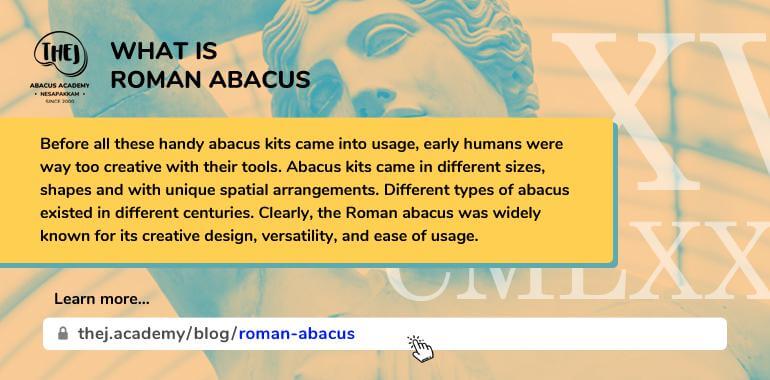Introduction
The human brain is beyond predictions and knows no limitations. The early humans had amazing creativity and out-of-the-box thinking that never failed to amaze us. With very few raw materials and smart work, they designed tools of all sorts, required for their usage.
We have been providing you valuable blogs on the abacus and its type for the past few months now. Now, it’s high time we take a walk through history.
Before all these handy abacus kits came into usage, early humans were way too creative with their tools. Abacus kits came in different sizes, shapes and with unique spatial arrangements. Different types of abacus existed in different centuries. Clearly, the Roman abacus was widely known for its creative design, versatility, and ease of usage.
Grab a coffee and read on, lets get to know the Roman abacus in detail.

Table of Contents
- What Is Roman Abacus?
- The Roman Abacus Design
- How Did Roman Calculate?
- The Roman Numeral Calculation
- Abacus, Their Integral Part of Their Lives
- Types of Romanian Abacus
- How Roman Abacus Changed with Time
- How Does the Roman Abacus Work
- How Abacus Played a Role in Their Counting System
- What Is Micro Calculators?
- Conclusion
What Is Roman Abacus?
Ancient Romans invented the Roman Abacus in the 1st century BC. It was a portable and basic version of the Greek and Babylonian abacus. The roman abacus served the purpose of solving basic arithmetic calculations like
- Addition
- Subtraction
- Multiplication and
- Division
This portable device reduced the amount of time taken to manipulate numbers. The Greek versions influenced the design of the Roman Abacus. Nonetheless, it served its purpose right. So, the Roman abacus was a great success!
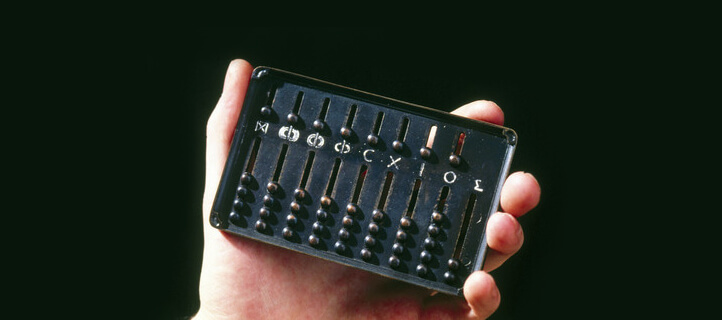
The Roman Abacus was an inspired version of the Greek Abacus. Since it was an influenced version, there isn’t a particular ‘Inventor’ to whom all the credits go to. Romans, collectively deserve the Glory for this worthy invention.
The Roman Abacus Design
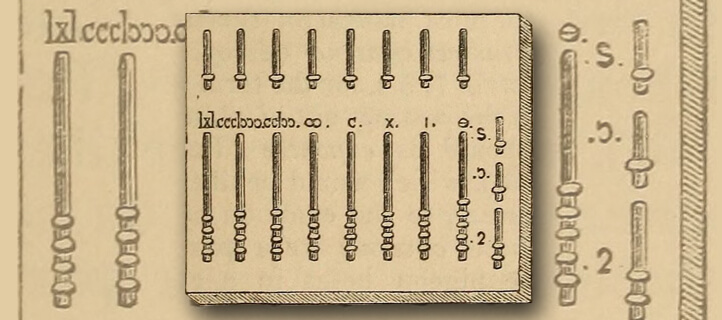
The Romans designed the abacus more like a metal plate. It had beads running in slots. They had one bead above and four beads below the bar, typically resembling the Japanese Soroban abacus. Knowing the benefits of the abacus, the Romans designed it creatively. It was used to perform all kinds of arithmetic operations.
This simple device was even used while constructing ships.
Can you believe this?
The lower groove marked I indicates units, X tens, and so on up to millions. The two rightmost columns differed from the other columns. Those columns were used for ‘mixed-base math’, a unique math developed by the Romans. The beads in the upper shorter grooves denote fives—five units, five tens, etc. Also, the longer slot with more than 4 beads were used to count 1/12 of a whole unit.
The beads up and down to indicate their values in the calculation with their position. Indeed, this made the Roman Abacus so unique. This made the Roman Abacus so unique. Hence, the abacus was used in the Roman measures and Roman currencies.
How Did Roman Calculate?
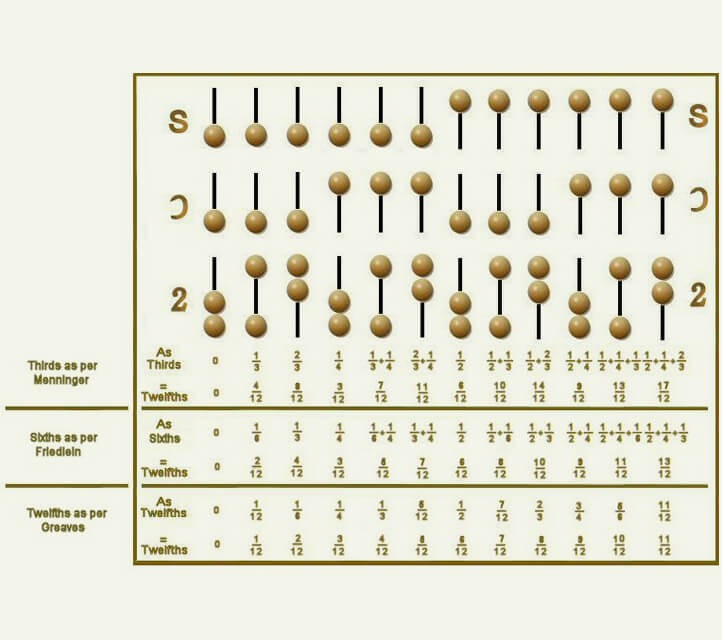
The Roman abacus evolved stage by stage. Firstly, from using sand to calculate. Secondly, a structured board. Finally, the Romans used Abacus to calculate, by using the Roman numerals. Also, they called the counting board Calculi. It means little pebbles.
Nonetheless, the earlier design had a confusing structure. They had numerous columns, leading to confusion. With time, they designed a much simpler Abacus kit that consisted of seven long and shorter grooves.
The upper grooves had one bead. On the other hand, the lower ones had four beads. The last two columns were indeed used for the Roman mixed-base math.
The beads in the upper groove marked the place value of fives. The lower grooves marked the place value from tens to millions. The symbols on the lower slot indicated the columns used for different calculations and a particular type of fractions. Moreover, a simple device being able to perform so many calculations fascinated the Romans to a great extent. It was indeed an integral part of every construction.
The Roman Numeral Calculation
The Romans used a much theoretical method of calculation when it came to Math. Not to mention, Romans were the first ones to use calculation in Mechanics, Structural Engineering, and the creation of Solar and Lunar calendars. Obviously, the Romans were also extremely curious about Trigonometry. The question here is, did Abacus play a part in all of it? Yes, it did! The Roman abacus looks like a simple device. Clearly, it was capable of many complex calculations beyond addition and subtraction.
They used roman numerals instead of numbers to do calculations, in the first place. All their numerals were a string of roman letters. In addition, they added the values together. The below table represents the rules for writing Roman numerals.
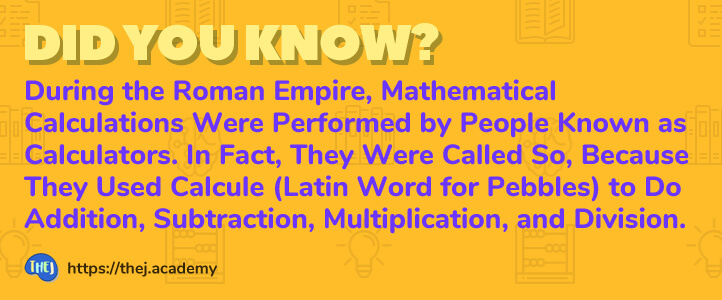
The below table represents the rules for writing Roman numerals.
| Roman Numerals | Numbers |
|---|---|
| I | 1 |
| V | 5 |
| X | 10 |
| L | 50 |
| C | 100 |
| D | 500 |
| M | 1000 |
For instance, here is a sample calculation:
XVX = 10 + 50 + 10 = 70
When a smaller value was placed before a larger one, it meant subtraction.
IX = 10 – 1 = 9
Can this get any more confusing?
Imagine calculating larger numbers in this method. But yeah, the Romans did it.
982 = 900 + 80 + 2 = CM + LXXX + II = CMLXXXII. This looks more like a cryptogram than a mathematical problem, we hear you! These calculations were done on the Roman Hand Abacus. But how? By moving the pebbles up and down!
Abacus, Their Integral Part of Their Lives
The Romans were quite creative and indigenous people in terms of their contribution to Mathematics. Moreover, with the Advent of Roman numerals, counting was made possible even without numbers. (by using only symbols).
Following that came the Roman abacus. Not to mention, it was so versatile that it came in different sizes and was portable too. As inquisitive the Romans got with their constructions, educational system, and modes of transport, the abacus became a more and more integral part of their lives. From counting currency to integers, the Romans relied on the abacus for the calculation.
As time passed, Romans realized that numbers and calculations emerged as a vital part of trade and commerce. They developed an easier way to use the abacus called the ‘Roman Hand Abacus’. It was a stone table with movable stones sliding up and down. Likewise, they started making it in different sizes, suiting individual purposes.
From being a mere calculation device to becoming a most used tool, the abacus rose to fame and was used by almost everyone who had counting needs.
Types of Romanian Abacus
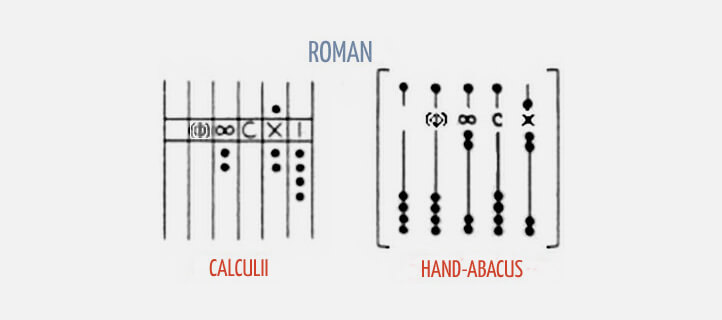
The Romans invented three different types of the abacus.
- The Dust Abacus
- The Line Abacus and
- The Grooved Abacus
The rows represented the place value of numbers accordingly. The difference in every type is mainly the material, frame, and the number of beads. The place values always remained the same in all its forms.
How Roman Abacus Changed with Time
With the advent of time, different types of abacus were developed all over the world. The Romanians advanced to a newer calculating device called the Jetons. These Jetons were nothing but lines with indicative units with marked values.

Later on, Pope Sylvester II reintroduced the traditional Roman abacus with few effective modifications. These changes made the Europeans go gaga about the abacus all over again. This modified abacus was based on wires, rather than a solid frame and this made counting easier and faster.
How Does the Roman Abacus Work
The seven longer and shorter grooves on the Roman abacus were used to count whole numbers. The longer columns had 4 beads each and the shorter ones had one bead each.
The lower slot had the following indications.
- I indicated units/ones
- X indicated tens
- C indicated hundreds, and so on.
Apart from this, The upper slot denoted fives in ones, tens, and so on.
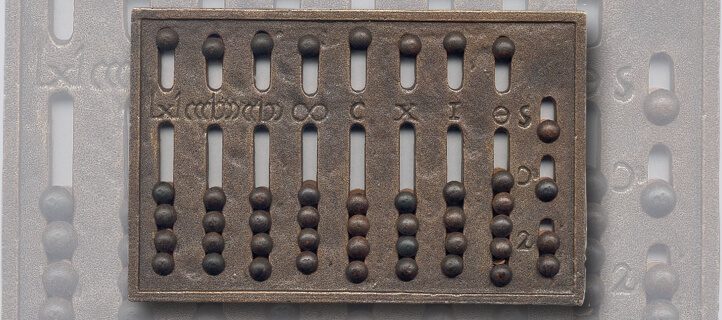
The beads on the lower slot were pushed up for ones and the beads on the upper slot were pushed down for fives. The columns decided the place value. This detailing and functionality made the Roman abacus mostly used for counting currencies. The rarely used columns were the rightmost ones. All that one had to know to use a Roman abacus was the place value of the beads. This was enough to work using an abacus.
How Abacus Played a Role in Their Counting System
The civilization that began with a stylus and a clay tablet, is re-using those original terms today. Even before the advent of calculators, the abacus was used to calculate fractions, decimals, and integers. Although computers, mobiles, and calculators are used as a mode of calculation, the abacus still remains as a mode of calculation in some countries.
The roman contribution to the abacus wasn’t exactly mind-blowing due to the complexity of the roman numerals. Come on, how can one easily comprehend a bunch of symbols put together, especially in the case of complicated arithmetic calculations?
The Roman numerals did not have a defined place value system. Therefore manipulating larger numbers was always a spin around the world.
Also, in those days, Midbrain activation was not a common practice in education. Counting played a major part, and that was it. The Roman abacus not only lacked clarity and definition due to its numeral system but also had undefined place values. But, the abacus played a major role in helping them convert their numerals into a place-based system, do the calculation and then convert back.
The Roman abacus used stone pebbles earlier. Several new materials showed up later on. The user got to decide the material of the abacus, based on his status.
What Is Micro Calculators?
In short, with time and technological advancement, Romans moved on to the next available option for calculating.
In the 19th century, people started using calculators. Manual calculations and abacus became rare. As time passed by, with the advent of modern technologies, the Romans switched to micro calculators in 1974.

This transmission happened and immediately spread over all of Rome. The micro calculators were portable, lightweight and made calculations so much easier. This saved them time and energy. Many schools around the world still teach traditional Roman abacus, irrespective of the rise of calculators.
Conclusion
To summarize, many new devices can speed up your calculation time and save energy. But, what is the point in making everything automated? The human brain is extraordinary and distinguished. If you think about it, behind all the greatest inventions of the world, is the humble human brain. When used for its fullest potential, the human brain can hold tonnes of data with impeccable memory.
Replacing an abacus with a calculator may sound smart. But the question is, are we not going to give our brains a chance to explore its capability?
We at Thej Academy teach abacus for kids passionate about learning and exploring their mental abilities. Here are the answers to all your questions regarding the abacus and the courses at Thej Academy. Still hesitant to give us a call, take a glance at what our students and parents have to say about the coaching at Thej Academy.

